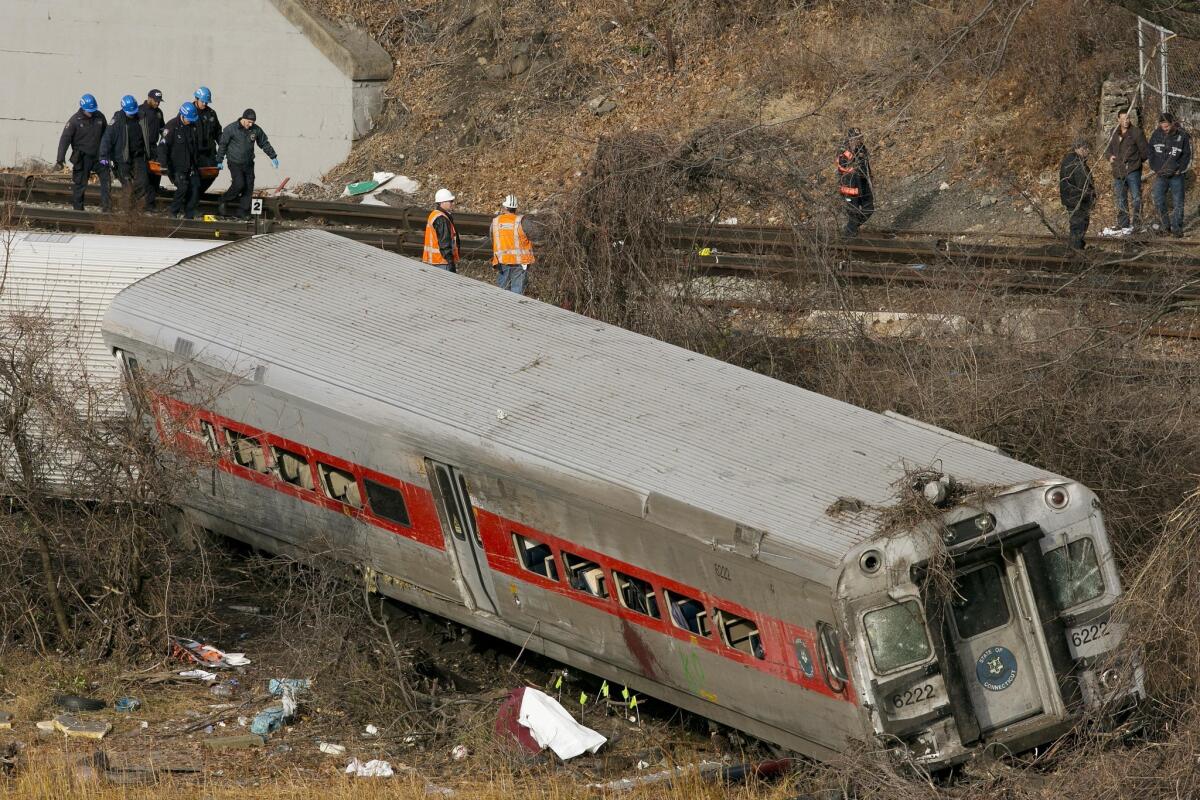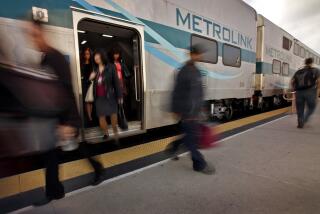Derailed New York train was traveling in area with 30 mph speed limit

- Share via
NEW YORK -- The speed limit on the tracks where a New York City passenger train derailed Sunday is 30 mph, officials said as they began investigating whether speed was a factor in the early morning crash that killed four people on the busiest travel day of the holiday season.
A team of National Transportation Safety Board investigators was expected on the scene Sunday, where cars of the Metro-North Railroad train remained scattered across the tracks hours after the 7:20 a.m. crash.
Some lay just feet from the waters of the Harlem River, where they were hurled as Metro-North’s 8808 out of Poughkeepsie ran off the tracks near the Spuyten Duyvil station in the Bronx. Fire officials said three of the four people confirmed dead were found outside the train, thrown from the train during the crash. Several of the injured had to be cut out of the wreckage.
More than 60 people were injured, 11 of them critically, in the second major incident since May involving the Metro-North Railroad, the nation’s second-busiest commuter railway in terms of monthly ridership. On May 17, dozens of people were injured, several seriously, when two Metro-North trains collided in Connecticut during rush hour.
Last July, a train hauling trash derailed on Metro-North tracks. Nobody was injured in that incident, which also occurred near the Spuyten Duyvil station.
“We’re going to be looking at all those events to identify if there are any common issues, any similarities, anything that needs to be done,” NTSB Chairwoman Deborah Hersman told NY1 television. “We need to keep our minds open until we can gather the facts,” she said.
U.S. Sen. Richard Blumenthal (D-Conn.) said whatever the cause of the crash, it underscored the need for Metro-North to “confront questions about adequacy of equipment, tracks and maintenance and repair practices.”
“Riders are losing patience with this railroad, and so am I,” he said.
Speed, the activities of the train’s operator, equipment failures and criminality are among the potential areas of investigation.
Soon after the derailment, President Obama was briefed by Lisa Monaco, his assistant for homeland security and counterterrorism.
MTA spokeswoman Marjorie Anders said the train was a diesel train, with seven coaches pushed by a locomotive. It had left Poughkeepsie shortly before 6 a.m., as scheduled, and was due to arrive at Manhattan’s Grand Central Terminal at about 7:40 a.m.
The train was not scheduled to stop at Spuyten Duyvil, which is where the Harlem and Hudson rivers meet. Trains passing through the area have a 30 mph speed limit as they round the curve at that point on the track, said Anders, noting that the speed limit on straight tracks is often upward of 70 mph.
Anders told NY1 that the train’s engineer was the one who called in to report the accident and that the call was recorded. In addition, there in an event recorder, often referred to as a black box, on each train.
“The maximum allowable speed in that area is 30 miles per hour,” Anders said. “What the actual speed was will be determined by downloading the event recorder.”
Anders described the train’s engineer as a 20-year veteran with “an unvarnished record, from all accounts.”
The New York police commissioner, Raymond Kelly, said there were three conductors and a motorman on the train and that all were accounted for.
Witness accounts varied, with some people saying they thought the train was traveling very quickly but others not noticing anything unusual as the train traveled toward Manhattan. Some on the train, and also people living in an apartment building very close to the scene, described hearing loud noises just before the derailment.
Jodie Colon told WABC-TV that she heard a loud “boom, boom, boom” as she was getting ready for church. “A little later I saw flashing lights,” she said.
“You live near the trains, you get used to train noises. I just heard that strange noise and didn’t realize, until I saw the flashing lights, what had happened,” she said.
A man who said he rides the train each Sunday, Frank Tatulli, told WABC he thought the train was moving “a lot faster” than usual as it rounded the curve. Tatulli said he was riding in the first car of the train.
Another passenger, Steven Cicconi, said he did not notice anything unusual, but heard a “loud shifting noise” before the derailment. “The next thing I knew, two people from across the train came flying at me,” he told NY1. “Of course it seemed a lot faster as it was happening, but nothing was suspicious at all.”
Authorities haven’t released names of the victims or the Metro-North crew members. The MTA set up a center at a nearby high school for family members to get information. Police also said people could call (718) 817-7444 to seek information on relatives who might have been on the train.
[For the record, 1:17 p.m., Dec. 1: An earlier version this post gave an incorrect number for the train. It was the 8808 train, not the 8088]
ALSO:
Cardinal Dolan says Catholic church “caricatured as anti-gay”
Tucson pair accused of imprisoning sisters to appear in court
Freaky, huge ice disc found spinning in North Dakota river
More to Read
Sign up for Essential California
The most important California stories and recommendations in your inbox every morning.
You may occasionally receive promotional content from the Los Angeles Times.











